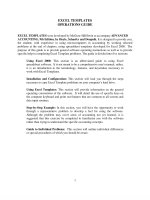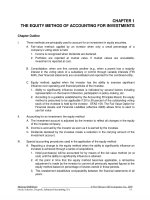Solution manual advanced accounting 2nd by hamlen CH10
Bạn đang xem bản rút gọn của tài liệu. Xem và tải ngay bản đầy đủ của tài liệu tại đây (1.47 MB, 50 trang )
Find more at www.downloadslide.com
CHAPTER 10
SOLUTIONS TO MULTIPLE CHOICE QUESTIONS, EXERCISES AND PROBLEMS
MULTIPLE CHOICE QUESTIONS
1.
c
2.
c
3.
a
4.
a
5.
d
Appropriations (= 20,000,000 + 500,000)
Less expenditures
Less encumbrances
Available funds
6.
$ 20,500,000
(7,600,000)
(75,000)
$ 12,825,000
b
The budget entry added $243,000 to fund balance, as follows:
Estimated revenues
Estimated other financing
sources
1,290,000
60,000
Appropriations
Estimated other financing
uses
Fund balance—
unassigned
1,085,000
22,000
243,000
Therefore the fund balance prior to the budget entry was $285,000 - $243,000 = $42,000.
Solutions Manual, Chapter 10
©Cambridge Business Publishers, 2013
1
Find more at www.downloadslide.com
7.
d
Closing entries are:
Property tax revenues
Speeding ticket revenues
Transfers in
Bond proceeds
950,000
400,000
8,000
50,000
Estimated revenues
Estimated other financing
sources
Fund balance—
unassigned
Appropriations
Estimated other financing uses
1,290,000
60,000
58,000
1,085,000
22,000
General expenditures
Capital outlay
Debt service: principal
Debt service: interest
Transfers out
Fund balance—
unassigned
1,015,000
25,000
2,000
8,000
20,000
37,000
$58,000 + $37,000 = $95,000
8.
d
General expenditures
Capital outlay
Debt service: principal payments
Debt service: interest payments
Total expenditures
9.
$1,015,000
25,000
2,000
8,000
$1,050,000
b
Cash
Taxes receivable, net
Due from other funds
Total
©Cambridge Business Publishers, 2013
2
$371,000
68,000
12,000
$451,000
Advanced Accounting, 2nd Edition
Find more at www.downloadslide.com
10.
b
Original assessment of 2013 taxes $1,000,000 - $25,000
End of year adjustment in allowance ($60,000 - $15,000) - $25,000
Excess cash collected on 2012 taxes $30,000 - $21,000
Total property tax revenue for 2013
$975,000
(20,000)
9,000
$964,000
Or alternatively,
2013 taxes collected
Uncollected 2013 taxes expected to be collected in early 2014
Excess collections on 2012 taxes $30,000 - $21,000
Total property tax revenue for 2013
Solutions Manual, Chapter 10
$940,000
15,000
9,000
$964,000
©Cambridge Business Publishers, 2013
3
Find more at www.downloadslide.com
EXERCISES
E10.1
1.
2.
3.
4.
5.
6.
7.
8.
9.
10.
11.
12.
13.
14.
E10.2
1.
2.
3.
4.
5.
6.
7.
8.
9.
10.
11.
12.
13.
Identify Appropriate Fund
special revenue
capital project
enterprise
agency
internal service
pension trust
agency
capital project
debt service or general fund
general
special revenue
debt service
permanent
private-purpose trust
Identify Appropriate Fund(s)
debt service fund
special revenue fund
general fund (for transfer to capital projects fund and for processing and receiving the
assessments), capital projects fund (for construction activities)
general fund (for processing assessments and receiving and distributing money from the
assessments), capital projects fund (for construction activities), and (a) debt service fund
(for receiving the assessments from the general fund and servicing the debt); (b) agency
fund (for processing the assessments, accounting for and servicing the debt)
capital projects fund
general fund (for transfer of withheld wages), pension trust fund
general fund
internal service fund
general fund
general fund
general fund (for transfer of withheld wages), agency fund
general fund (if museum activities are reported in the general fund), permanent fund
investment trust fund
©Cambridge Business Publishers, 2013
4
Advanced Accounting, 2nd Edition
Find more at www.downloadslide.com
E10.3
Property Tax Rate and Revenues
a.
Last year’s property tax revenue was: $7,920,000 = $.88 x ($900,000,000/$100)
b.
Property tax revenue required is $8,645,000 = $9,500,000 - $855,000
$8,645,000/($950,000,000/$100) = $0.91 per $100 of assessed valuation
c.
$0.88 x ($950,000,000/$100) = $8,360,000
E10.4
Computing Available Funds
All dollar amounts in thousands
a.
Funds available for encumbrance consist of:
appropriations - expenditures - outstanding encumbrances
Appropriations are $3,800,000 (= estimated revenue of $4,000,000 – budgetary
surplus of $200,000). Thus,
available funds = $3,800,000 - 2,500,000 - 225,000 = $1,075,000
The other numerical data given are irrelevant to this calculation.
b.
Yes, the budget appears ripe for cutting. Operating costs average about $248,000 per
month [= (2,500,000 + 225,000)/11]. Yet there is $1,075,000 remaining to cover operating
costs of $248,000 in the last month of the fiscal year.
Solutions Manual, Chapter 10
©Cambridge Business Publishers, 2013
5
Find more at www.downloadslide.com
E10.5
Reconstruct Budget Entry, Compute Fund Balance
The detailed budget may be reconstructed as follows:
Over
(Under) Budget
Actual
Revenues:
Property taxes
Fines
Intergovernmental
Fees and service charges
Miscellaneous
Total
Expenditures:
Administration
Public safety
Health and environment
Total
a.
Budget
$2,975,000
6,000
12,000
500,000
4,000
$3,497,000
$125,000
6,000
0
(75,000)
(1,000)
$ 55,000
$2,850,000
0
12,000
575,000
5,000
$3,442,000
$ 500,000
2,050,000
950,000
$3,500,000
$
$ 501,000
2,056,000
954,000
$3,511,000
1,000
6,000
4,000
$ 11,000
Therefore, the budget entry was:
Estimated revenues
Fund balance-unassigned
3,442,000
69,000
Appropriations
3,511,000
b.
Fund balance, beginning of year
Budget entry effect (planned decrease)
Excess of actual revenues over budgeted revenues
Excess of budgeted expenditures over actual expenditures
Fund balance, end of year
Alternative calculation:
Fund balance, beginning of year
Excess of expenditures over revenues
Fund balance, end of year
©Cambridge Business Publishers, 2013
6
$2,100,000
(69,000)
55,000
11,000
$2,097,000
$2,100,000
(3,000)
$2,097,000
Advanced Accounting, 2nd Edition
Find more at www.downloadslide.com
E10.6
Transactions, Closing Entries, and Budgetary Comparison Schedule
All dollar amounts in thousands
a.
Journal entries:
(1)
Estimated revenues
51,000
Appropriations
51,000
Taxes receivable
41,000
Property tax revenues
41,000
(2)
Cash
18,500
Taxes receivable
18,500
Cash
26,500
Taxes receivable
26,500
(3)
Encumbrances
50,300
Fund balance—assigned
(4)
Fund balance—assigned
50,300
37,300
Encumbrances
37,300
($50,300 - $13,000 = $37,300)
Expenditures
37,500
Accounts payable
37,500
(5)
Accounts payable
44,000
Cash
44,000
(6)
Cash
11,000
Fee and service revenues
Solutions Manual, Chapter 10
11,000
©Cambridge Business Publishers, 2013
7
Find more at www.downloadslide.com
b.
Closing entries:
Property tax revenues
Fee and service revenues
41,000
11,000
Fund balance—unassigned
Estimated revenues
1,000
51,000
Appropriations
51,000
Fund balance—unassigned
Expenditures
Encumbrances
c.
500
37,500
13,000
$38,500 = $37,000 + $1,000 + $500
d.
Budgetary Comparison Schedule
For the Year Ended December 31, 2013
Variance—
Favorable
Budget
Actual
(Unfavorable)
Revenues
$51,000
$52,000
$ 1,000
Expenditures
51,000
37,500
13,500
Change in fund balance (1)
$
0
$14,500
$14,500
(1) Closing entries $1,000 + $500 plus increase in fund balance—assigned $13,000.
©Cambridge Business Publishers, 2013
8
Advanced Accounting, 2nd Edition
Find more at www.downloadslide.com
E10.7
Property Tax Transactions
a.
Taxes receivable—
current
30,000,000
Allowance for uncollectible
taxes—current
Revenues
To record tax levy and establish allowance for uncollectible taxes.
Cash
Revenues
1,200,000
28,800,000
9,009,000
91,000
Taxes receivable—current
9,100,000
To record collection of taxes prior to due date and reduction of revenues by 1% discount
($9,100,000 = $9,009,000/.99).
Cash
18,900,000
Taxes receivable—current
To record collection of taxes prior to January 1;
$18,900,000 = $30,000,000 - $9,100,000 - $2,000,000.
18,900,000
Taxes receivable—
delinquent
2,000,000
Taxes receivable—current
To reclassify taxes declared delinquent on January 1.
2,000,000
Allow. for uncollectible
taxes—current
Revenues
1,200,000
600,000
Allow. for uncollectible
taxes—delinquent
1,800,000
To adjust the allowance for delinquent taxes to $1,800,000 (= $2,000,000 - $200,000).
Cash
Allow. for uncollectible
taxes—delinquent
300,000
1,800,000
Taxes Receivable—
delinquent
Revenues
To record collection of delinquent taxes subsequent to January 1.
Expenditures
Cash
To record cash expenditures for the year.
Solutions Manual, Chapter 10
2,000,000
100,000
25,000,000
25,000,000
©Cambridge Business Publishers, 2013
9
Find more at www.downloadslide.com
b.
Balance sheet accounts
Cash ($850,000 + $9,009,000 + $18,900,000 + $300,000 - $25,000,000)
Fund balance:
Actual revenues ($28,800,000 - $91,000 - $600,000 + $100,000)
Estimated revenue
Decrease in fund balance with closing entry
Beginning fund balance after the budget entry
Ending fund balance
E10.8
$ 4,059,000
$28,209,000
29,000,000
(791,000)
5,200,000
$ 4,409,000
Inventory Accounting
a.
Consumption method
Expenditures (1)
Inventory (2)
17,900,000
100,000
Cash
Accounts payable
Fund balance – unassigned (2)
15,500,000
2,500,000
100,000
Fund balance—
nonspendable (2)
100,000
Purchases method
Expenditures
18,000,000
Cash
Accounts payable
Inventory (2)
15,500,000
2,500,000
100,000
Fund balance—
nonspendable (2)
100,000
(1) 17,900,000 = 1,000,000 + 18,000,000 – 1,100,000
(2) 100,000 = 1,100,000 – 1,000,000
©Cambridge Business Publishers, 2013
10
Advanced Accounting, 2nd Edition
Find more at www.downloadslide.com
E10.9
Closing Entries
a.
Revenues
3,501,000
Estimated revenues
3,501,000
Appropriations
3,449,000
Expenditures
3,449,000
b.
Revenues
3,501,000
Estimated revenues
3,501,000
Appropriations
3,449,000
Expenditures
Fund balance—unassigned
3,427,000
22,000
c.
Revenues
Fund balance—unassigned
3,440,000
61,000
Estimated revenues
3,501,000
Appropriations
3,449,000
Expenditures
Fund balance—unassigned
3,440,000
9,000
d.
Revenues
Fund balance—unassigned
3,495,000
6,000
Estimated revenues
3,501,000
Appropriations
3,449,000
Expenditures
Fund balance—unassigned
Solutions Manual, Chapter 10
3,443,000
6,000
©Cambridge Business Publishers, 2013
11
Find more at www.downloadslide.com
E10.10
a.
Carryover Encumbrances
Legal budgetary basis
Expenditures—prior year
encumbrances
1,965,000
Accounts payable
To record invoices for goods and services ordered in 2012.
Fund Balance—assigned
Fund balance—unassigned
1,965,000
1,900,000
65,000
Expenditures—prior year
encumbrances
To close encumbrances carried over from 2012 and related expenditures.
b.
1,965,000
GAAP budgetary basis
Encumbrances
1,900,000
Fund balance—unassigned
To restore encumbrances carried over from 2012.
Fund balance—assigned
1,900,000
1,900,000
Encumbrances
To reverse encumbrances for goods and services received.
Expenditures
Accounts payable
To record invoices for goods and services.
1,900,000
1,965,000
1,965,000
No special closing entry is required; expenditures are closed in the normal manner.
E10.11
1.
2.
3.
4.
5.
6.
Interfund Transactions
Balance sheet asset: Due from special revenue fund
Statement of revenues, expenditures, and changes in fund balances: Transfers out, listed
under other financing uses
Statement of revenues, expenditures, and changes in fund balances: Transfer in, listed
under other financing sources
Statement of revenues, expenditures, and changes in fund balances: Expenditures
Balance sheet asset: Due from enterprise fund
Balance sheet: reduces Due from special revenue fund
©Cambridge Business Publishers, 2013
12
Advanced Accounting, 2nd Edition
Find more at www.downloadslide.com
E10.12
Adjusting and Closing Entries, Balance Sheet
a.
Taxes receivable—
delinquent
800,000
Taxes receivable—current
To reclassify receivables outstanding at year end as delinquent.
Allowance for uncollectible
taxes—current
Revenues
800,000
450,000
350,000
Allowance for uncollectible
taxes—delinquent
To fully reserve delinquent taxes.
Fund balance—
nonspendable
800,000
30,000
Supplies
To adjust ending supplies balance.
30,000
Fund balance—assigned
450,000
Expenditures—prior year
Fund balance—unassigned
To close prior year encumbrances and related expenditures.
Revenues
420,000
30,000
13,650,000
Estimated revenues
Fund balance—unassigned
13,000,000
650,000
To close revenues.
Appropriations
11,000,000
Expenditures
Encumbrances
Fund balance—unassigned
To close expenditures and encumbrances.
Solutions Manual, Chapter 10
10,500,000
300,000
200,000
©Cambridge Business Publishers, 2013
13
Find more at www.downloadslide.com
b.
Assets
Cash
Taxes receivable-delinquent
(less $800,000 allowance for
uncollectible delinquent
taxes)
Due from other funds
Supplies
Total
$3,500,000
0
120,000
250,000
________
$3,870,000
Liabilities and Fund Balances
Accounts payable
$1,800,000
Due to other funds
Fund balances:
Nonspendable
Assigned
Unassigned
Total
Graystone General Fund
Analysis of changes in fund balance - unassigned
(not required)
Fund balance (deficit), beginning (See Note 1)
Excess of revenues over expenditures:
Revenues
$13,650,000
Expenditures (including encumbrances of $300,000)
10,800,000
Fund balance, ending
Note 1: The beginning unassigned fund balance is calculated as follows:
Fund balance, beginning (plug)
Add: amount credited in budget entry
($13,000,000 estimated revenues less $11,000,000 appropriations)
Balance per trial balance
Beginning balance implied above
Add: adjustment for excess prior year's encumbrance over expenditure
Beginning balance as adjusted
©Cambridge Business Publishers, 2013
14
210,000
250,000
300,000
1,310,000
$3,870,000
($1,540,000)
2,850,000
$ 1,310,000
$(1,570,000)
2,000,000
430,000
(1,570,000)
30,000
$(1,540,000)
Advanced Accounting, 2nd Edition
Find more at www.downloadslide.com
E10.13
a.
General Fund Capital Asset and Long-Term Debt Transactions
1.
Capital outlay
2,250,000
Cash, accounts payable
2,250,000
2.
Cash
370,000
Proceeds from sale of capital
assets
3.
Debt service: interest
Debt service: principal
2,000,000
500,000
Cash
b.
370,000
2,500,000
All transactions are reported in the general fund=s Statement of Revenues, Expenditures,
and Changes in Fund Balances.
Capital outlay of $2,250,000 is reported as an expenditure.
Proceeds from sale of capital assets of $370,000 is reported as other financing sources.
Debt service: principal of $500,000 and debt service: interest of $2,000,000 are reported as
expenditures.
c.
Effect on general fund unassigned fund balance: $(4,380,000) = - $2,250,000 + $370,000 $2,000,000 - $500,000.
Solutions Manual, Chapter 10
©Cambridge Business Publishers, 2013
15
Find more at www.downloadslide.com
E10.14
Identifying the Reporting Entity
1.
The school district is a discretely presented component unit. The city is financially
accountable for the school district—the city approves its budget and is legally liable for its
debt. The city also provides significant funding. Financial results are discretely presented
rather than blended because the district has a different governing body.
2.
The housing authority is not a component unit of the city. The city is not financially
accountable for it.
3.
The landfill is a discretely presented component unit. The city is financially accountable
because it controls the board and sets landfill rates.
4.
The sewer district is not a component unit of the city, since the city does not control its
board, and is not financially liable for its activities.
5.
The building authority is a blended component unit of the city. It is a component unit
because the city appoints the board and is liable for the authority=s debts. The building
authority=s financial information is blended with that of the city because the authority
provides services entirely to the city.
©Cambridge Business Publishers, 2013
16
Advanced Accounting, 2nd Edition
Find more at www.downloadslide.com
PROBLEMS
P10.1
Determining the Reporting Entity
1.
Megalopolis is the primary government. The Convention Authority (CA) should be
included with Megalopolis for financial reporting purposes. The city appoints the CA's
governing board and, even though it appears that the city will not be subsidizing the CA,
bonds issued by the CA and backed (guaranteed) by the city impose a financial burden on
the city. Megalopolis is financially accountable to its constituents for the activities of the
CA.
2.
Megalopolis remains the primary government. However, the CA now appears to be a
separate financial reporting entity. Even though the city appoints the governing board, the
activities of the CA are essentially independent of the city. The CA may levy its own sales
tax and issue its own bonds. The bonds are not backed by the city and, presumably, will be
repaid with the CA's revenue. Council has no authority to approve or disapprove the CA's
plans and is neither financially impacted by nor financially accountable for the CA's
activities.
3.
Gigantic County is the primary government. Each volunteer fire department is a separate
not-for-profit financial reporting entity, not a component of the Gigantic county reporting
entity. The county has no control over the fire departments and contracts for their services
voluntarily. County expenditures for the capital equipment become analogous to the
contractual expenditures for fire-fighting services.
4.
The City of Winitville is the primary government. The Winitville Board of Education is
included with the city for financial reporting purposes. Separate election of school board
members is more than offset by the city's influence over the Board's ability to spend,
through its annual appropriation. Moreover, because the city provides the funding for the
Board of Education, the Board is fiscally dependent upon the city. In effect, the city is
accountable to taxpayers and creditors for the school board's operations.
5.
The State of Michigan is the primary government. The Great Lakes Protection Fund
(GLPF) is a separate joint venture not included with the state for financial reporting
purposes. Although Michigan is represented on the Board of the GLPF, the GLPF has its
own Articles of Incorporation and Michigan does not have control over decisions made.
The GLPF is also not fiscally dependent on the State of Michigan.
6.
The State of Georgia is the primary government. The Georgia Public Telecommunications
Commission is included as a component unit in the State financial reports. The State has
control over the Commission's ability to spend, and the Commission is financially
accountable to the State.
Solutions Manual, Chapter 10
©Cambridge Business Publishers, 2013
17
Find more at www.downloadslide.com
P10.2
a.
General Fund Entries and Financial Statements
Journal entries for 2013:
Estimated revenues
Fund balance—unassigned
7,450,000
1,650,000
Appropriations
9,100,000
To record 2013 budget. Estimated revenues are ($2,700,000 + $3,500,000 + $1,000,000 +
$250,000) and appropriations are ($6,700,000 + $1,150,000 + $750,000 + $350,000 +
$150,000).
Taxes receivable
2,700,000
Tax revenues
2,700,000
To accrue taxes receivable.
Cash
2,700,000
Taxes receivable
To record collection of property taxes.
2,700,000
Waste management
expenditures
6,680,000
Cash
To record expenditures for waste management.
6,680,000
Court expenditures
1,120,000
Cash
To record expenditures for court costs.
1,120,000
Cash
400,000
Accounts receivable—waste
management
To record receipt of payment on 2012 waste management bills.
Cash
Accounts receivable—
waste management
400,000
3,390,000
210,000
Waste management revenues
To record revenues from waste management.
Cash
Court fines
To record revenues from court fines.
©Cambridge Business Publishers, 2013
18
3,600,000
920,000
920,000
Advanced Accounting, 2nd Edition
Find more at www.downloadslide.com
Salaries and operating
expenditures
745,000
Cash
To record salaries and operating expenditures.
745,000
Investments
235,000
Interest revenue
To record interest revenue from investments.
235,000
Miscellaneous expenditures
149,000
Cash
To record miscellaneous expenditures.
149,000
Supplies expenditures
340,000
Waste management supplies
To record consumption of supplies inventory.
Fund balance—
nonspendable
340,000
340,000
Fund balance—unassigned
To adjust the nonspendable fund balance.
Closing entries:
Tax revenues
Water revenues
Court fines
Interest revenue
340,000
2,700,000
3,600,000
920,000
235,000
Estimated revenues
Fund balance—unassigned
To close revenues to fund balance.
Appropriations
9,100,000
Waste management
expenditures
Court expenditures
Salaries and operating
expenditures
Miscellaneous expenditures
Supplies expenditures
Fund balance—unassigned
To close expenditures to fund balance.
Solutions Manual, Chapter 10
7,450,000
5,000
6,680,000
1,120,000
745,000
149,000
340,000
66,000
©Cambridge Business Publishers, 2013
19
Find more at www.downloadslide.com
b.
Town of Amherst
General Fund
Statement of Revenues, Expenditures, and
Changes in Fund Balance
For the Year Ended December 31, 2013
Revenues:
Property taxes
Waste management service
Court fines
Interest
$ 2,700,000
3,600,000
920,000
235,000
$ 7,455,000
Expenditures:
Waste management department
Court costs
Salaries and expenditures
Supplies
Miscellaneous
Total expenditures
Excess of revenues over (under) expenditures
Fund balance—January 1, 2013
Fund balance—December 31, 2013
$ 6,680,000
1,120,000
745,000
340,000
149,000
9,034,000
(1,579,000)
10,280,000
$ 8,701,000
Town of Amherst
General Fund
Balance Sheet
December 31, 2013
Assets
Cash (1)
Investments
Accounts receivable—waste
management
Waste management supplies
Liabilities and fund balance
$2,216,000
6,235,000
210,000
40,000
$8,701,000
Fund balance—nonspendable
Fund balance –unassigned (2)
$
40,000
8,661,000
________
$8,701,000
(1) $2,216,000 = $3,500,000 + $2,700,000 - $6,680,000 - $1,120,000 + $400,000 +
$3,390,000 + $920,000 - $745,000 - $149,000.
(2) $8,701,000 = $9,900,000 - $1,650,000 + $5,000 + $66,000 + $340,000.
©Cambridge Business Publishers, 2013
20
Advanced Accounting, 2nd Edition
Find more at www.downloadslide.com
P10.3
General Fund Adjustments and Financial Statements
(in thousands)
a.
Adjusting and closing entries for the general fund:
(1)
Due from enterprise fund
2,000
Accounts receivable
To reclassify receivable from Golf Course Fund for advance.
(2a)
Taxes receivable—delinquent
2,000
10,000
Taxes receivable—current
To reclassify outstanding taxes as delinquent.
(2b)
Revenues
10,000
10,000
Allowance for uncollectible
taxes—delinquent
To record allowance for uncollectible taxes.
10,000
(3)
Expenditures
40,000
Bonds payable
40,000
To correct recording of retirement of general obligation bonds and payment of interest.
(4)
Supplies inventory
3,500
Fund balance—nonspendable
3,500
To record supplies inventory at year end and classify this amount as fund balance—
nonspendable.
(5)
Encumbrances
4,500
Fund balance—assigned
4,500
To record encumbering of appropriations for purchase orders outstanding at year end.
(6)
Due from State
9,000
Revenues
To record Town's portion of gasoline taxes collected by State.
Solutions Manual, Chapter 10
9,000
©Cambridge Business Publishers, 2013
21
Find more at www.downloadslide.com
(7a)
Expenditures
20,000
Town property
To correct recording of purchase of equipment.
20,000
(7b)
Town property
1,000
Proceeds from sale of capital
assets
To correct recording of sale of equipment.
1,000
Closing entries:
Appropriations
380,000
Expenditures
375,000
Encumbrances
4,500
Fund balance—unassigned
500
To close expenditures and encumbrances; $375,000 = $315,000 + $40,000 + $20,000.
Revenues
Proceeds from sale of capital
assets
Fund balance—unassigned
439,000
1,000
20,000
Estimated revenues
To close revenues accounts; $439,000 = $440,000 - $10,000 + $9,000.
b.
460,000
Town of Fountain Inn
General Fund
Statement of Revenues, Expenditures and Changes in Fund Balances
For the Year Ended June 30, 2014
(in thousands)
Revenues
$ 439,000
Expenditures
375,000
Excess of revenues over (under) expenditures
64,000
Other financing sources (uses):
Proceeds from sale of capital assets
1,000
Excess of revenues and other financing sources over expenditures and
other financing uses
65,000
Fund balances—July 1, 2013 (1)
(44,000)
Increase in inventories
3,500
Fund balances—June 30, 2014 (2)
$ 24,500
©Cambridge Business Publishers, 2013
22
Advanced Accounting, 2nd Edition
Find more at www.downloadslide.com
(1) The beginning total fund balance is $(44,000), calculated as follows:
Fund balances, beginning (plug)
Add: Amount credited in budget entry ($460,000 estimated revenues
less $380,000 appropriations)
Amount per trial balance
(2) Nonspendable
Assigned
Unassigned
Total fund balances
$ (44,000)
$
80,000
36,000
$ 3,500
4,500
16,500
$24,500
Town of Fountain Inn
General Fund
Balance Sheet
June 30, 2014
(in thousands)
Assets
Cash
Taxes receivable—delinquent
Allowance for uncollectible taxes
Due from enterprise fund
Due from State
Supplies inventory
Total assets
Liabilities and fund balances
Accounts payable
Fund balances:
Nonspendable
Assigned
Unassigned
Total liabilities and fund balances
Solutions Manual, Chapter 10
$ 28,000
$ 10,000
(10,000)
0
2,000
9,000
3,500
$ 42,500
$ 18,000
3,500
4,500
16,500
$ 42,500
©Cambridge Business Publishers, 2013
23
Find more at www.downloadslide.com
P10.4
Reconstructing General Fund Journal Entries
(in thousands)
Cash
23,000
Investments
To record liquidation of investments.
Due from state government
23,000
49,000
Revenues
49,000
To record anticipated state grant.
Cash
105,000
Due from federal
government
To record receipt of grant from federal government.
Expenditures—prior year
encumbrances
105,000
7,000
Accounts payable
To record expenditures for prior year's encumbrances.
Expenditures
7,000
92,000
Accounts payable
92,000
To record expenditures.
Computation of expenditures:
Unassigned fund balance decrease ($78,000 - $120,000)
Decrease from budget entry
Increase from prior year's encumbrances
Revenues less than budgeted
Expenditures less than appropriations (plug)
Unassigned fund balance decrease
Appropriations
Excess of appropriations over expenditures
Expenditures
©Cambridge Business Publishers, 2013
24
$ (42,000)
(30,000)
1,000
(16,000)
3,000
(42,000)
95,000
(3,000)
$ 92,000
Advanced Accounting, 2nd Edition
Find more at www.downloadslide.com
Accounts payable
109,000
Cash
To record payment of accounts payable; $109,000 = $42,000 + $7,000 +
$92,000 - $32,000.
Revenues
Fund balance—unassigned
109,000
49,000
16,000
Estimated revenues
65,000
To close revenues.
Appropriations
95,000
Expenditures
Fund balance—unassigned
92,000
3,000
To close expenditures.
Fund balance—assigned
8,000
Expenditures—prior year
encumbrances
Fund balance—unassigned
To close prior year encumbrance accounts.
P10.5
a.
7,000
1,000
General Fund—Corrections, Adjustments, and Financial Statements
Reclassification and adjusting entries for general fund (in thousands):
(1)
Due from Water Utility Fund
1,500
Accounts receivable
To reclassify receivable from water utility fund.
1,500
(2a)
Taxes receivable—delinquent
30,000
Taxes receivable—current
To reclassify current taxes now considered delinquent.
(2b)
Revenues
30,000
24,000
Allow. for uncollectible
taxes—delinquent
To establish an allowance account for taxes estimated to be uncollectible.
Solutions Manual, Chapter 10
24,000
©Cambridge Business Publishers, 2013
25









